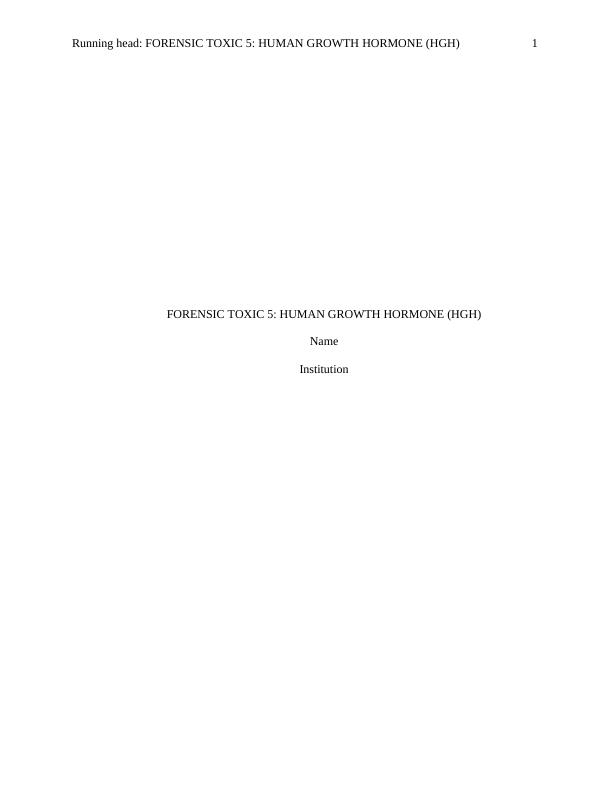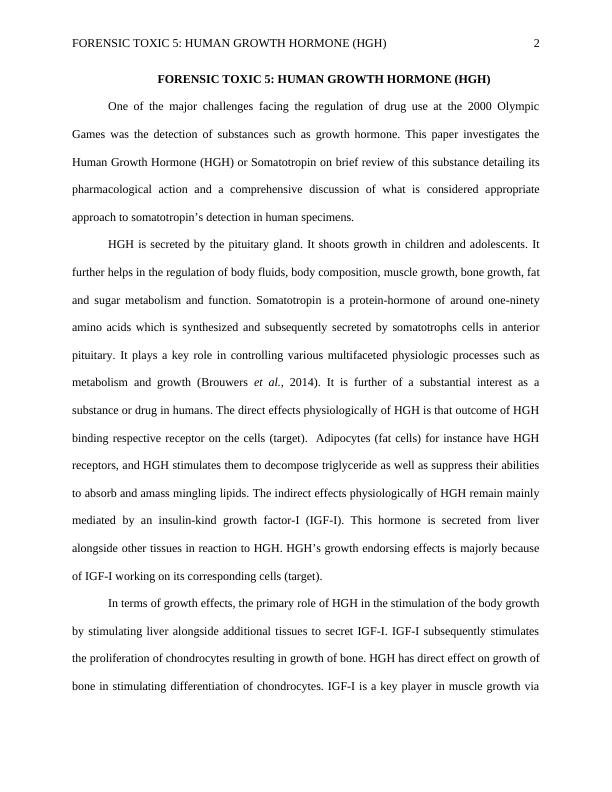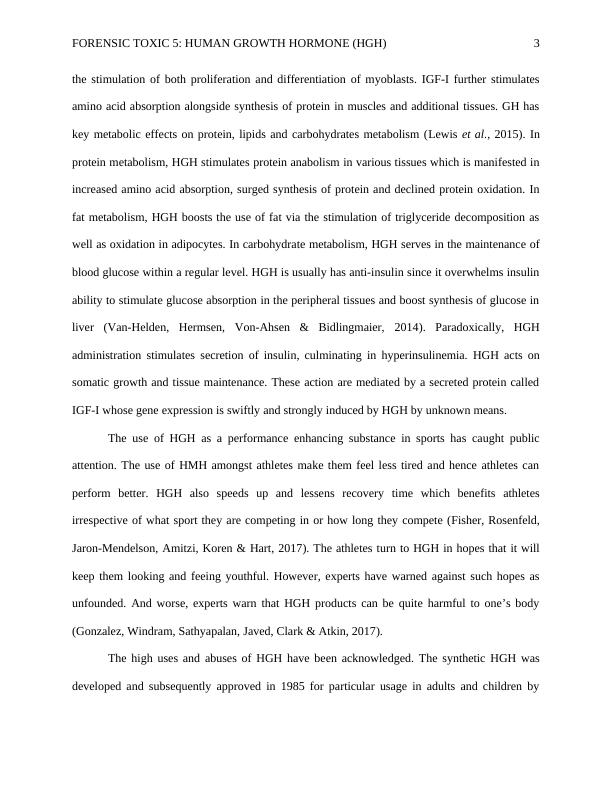Paper on Human Growth Hormone
Added on 2020-04-15
7 Pages1684 Words73 Views
Running head: FORENSIC TOXIC 5: HUMAN GROWTH HORMONE (HGH) 1FORENSIC TOXIC 5: HUMAN GROWTH HORMONE (HGH)NameInstitution

FORENSIC TOXIC 5: HUMAN GROWTH HORMONE (HGH) 2FORENSIC TOXIC 5: HUMAN GROWTH HORMONE (HGH)One of the major challenges facing the regulation of drug use at the 2000 OlympicGames was the detection of substances such as growth hormone. This paper investigates theHuman Growth Hormone (HGH) or Somatotropin on brief review of this substance detailing itspharmacological action and a comprehensive discussion of what is considered appropriateapproach to somatotropin’s detection in human specimens. HGH is secreted by the pituitary gland. It shoots growth in children and adolescents. Itfurther helps in the regulation of body fluids, body composition, muscle growth, bone growth, fatand sugar metabolism and function. Somatotropin is a protein-hormone of around one-ninetyamino acids which is synthesized and subsequently secreted by somatotrophs cells in anteriorpituitary. It plays a key role in controlling various multifaceted physiologic processes such asmetabolism and growth (Brouwers et al., 2014). It is further of a substantial interest as asubstance or drug in humans. The direct effects physiologically of HGH is that outcome of HGHbinding respective receptor on the cells (target). Adipocytes (fat cells) for instance have HGHreceptors, and HGH stimulates them to decompose triglyceride as well as suppress their abilitiesto absorb and amass mingling lipids. The indirect effects physiologically of HGH remain mainlymediated by an insulin-kind growth factor-I (IGF-I). This hormone is secreted from liveralongside other tissues in reaction to HGH. HGH’s growth endorsing effects is majorly becauseof IGF-I working on its corresponding cells (target). In terms of growth effects, the primary role of HGH in the stimulation of the body growthby stimulating liver alongside additional tissues to secret IGF-I. IGF-I subsequently stimulatesthe proliferation of chondrocytes resulting in growth of bone. HGH has direct effect on growth ofbone in stimulating differentiation of chondrocytes. IGF-I is a key player in muscle growth via

FORENSIC TOXIC 5: HUMAN GROWTH HORMONE (HGH) 3the stimulation of both proliferation and differentiation of myoblasts. IGF-I further stimulatesamino acid absorption alongside synthesis of protein in muscles and additional tissues. GH haskey metabolic effects on protein, lipids and carbohydrates metabolism (Lewis et al., 2015). Inprotein metabolism, HGH stimulates protein anabolism in various tissues which is manifested inincreased amino acid absorption, surged synthesis of protein and declined protein oxidation. Infat metabolism, HGH boosts the use of fat via the stimulation of triglyceride decomposition aswell as oxidation in adipocytes. In carbohydrate metabolism, HGH serves in the maintenance ofblood glucose within a regular level. HGH is usually has anti-insulin since it overwhelms insulinability to stimulate glucose absorption in the peripheral tissues and boost synthesis of glucose inliver (Van-Helden, Hermsen, Von-Ahsen & Bidlingmaier, 2014). Paradoxically, HGHadministration stimulates secretion of insulin, culminating in hyperinsulinemia. HGH acts onsomatic growth and tissue maintenance. These action are mediated by a secreted protein calledIGF-I whose gene expression is swiftly and strongly induced by HGH by unknown means. The use of HGH as a performance enhancing substance in sports has caught publicattention. The use of HMH amongst athletes make them feel less tired and hence athletes canperform better. HGH also speeds up and lessens recovery time which benefits athletesirrespective of what sport they are competing in or how long they compete (Fisher, Rosenfeld,Jaron-Mendelson, Amitzi, Koren & Hart, 2017). The athletes turn to HGH in hopes that it willkeep them looking and feeing youthful. However, experts have warned against such hopes asunfounded. And worse, experts warn that HGH products can be quite harmful to one’s body(Gonzalez, Windram, Sathyapalan, Javed, Clark & Atkin, 2017). The high uses and abuses of HGH have been acknowledged. The synthetic HGH wasdeveloped and subsequently approved in 1985 for particular usage in adults and children by

End of preview
Want to access all the pages? Upload your documents or become a member.
Related Documents
Biochemistry Assignment (Doc)lg...
|5
|921
|119
Current Perspective in Biosciencelg...
|16
|4633
|69
Molecular Components Assignment Reportlg...
|4
|1394
|15
Adaptation of the Ketogenic Dietlg...
|2
|613
|28
Nitrogen Metabolism in Human Bodylg...
|9
|1466
|168
Function of Synthesis of Insulin - MELS230lg...
|6
|2220
|58
